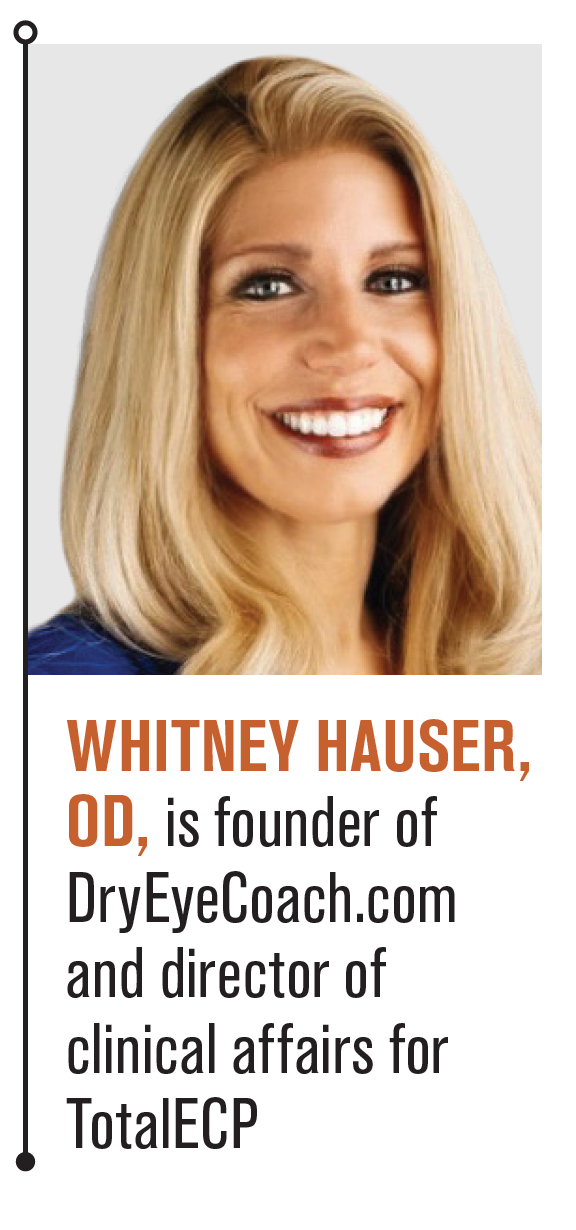Protect patients’ eyes by encouraging a three-step ocular wellness regimen
An ocular wellness regimen doesn’t need to be complicated—simply wipe, spray, and warm


With practices re-opening from the COVID-19 pandemic, it is time for ODs to stress healthy lid and lash care as much as they stress hand washing. A simple, three-step wellness routine can help patients remove debris, fight infection, reduce inflammation and enhance the eyes’ ability to heal between office visits. Keep it simple: wipe the eyes clean with a face wash or makeup remover, spray the lids with a pure hypochlorous acid spray, and use a warm compress.
With many offices currently not back to 100 percent capacity due to the pandemic, ODs are contemplating how to care for patients who have extended gaps between visits. What can they do to be helpful and proactive?
The answer is simple: Encourage patients to do what they should have been doing all along—that is, practice good ocular hygiene. With all the talk about the importance of hand washing during COVID-19, patients may be much more receptive to ODs’ ocular wellness recommendations.

What constitutes a wellness regimen
Three easy steps—wipe, spray, and warm—are all that’s needed to get patients on the right path.
First, patients should gently cleanse the lid area with a specialty wipe, makeup remover, or gentle face wash. This will help remove bulky debris and makes the area more receptive to Step 2.
Step 2 involves spraying the lids with a pure hypochlorous acid spray solution. One to 2 sprays can help fight infection, reduce inflammation, control the body’s response to injury, and enhance its natural ability to heal. Importantly, hypochlorous acid should be an integral part of any hygiene routine at the moment because it demonstrates broad-spectrum antimicrobial activity.1 Importantly, several hypochlorous acid preparations are currently listed on the United States Environmental Protection Agency’s list of disinfectants for use against SARS-CoV-2, the novel coronavirus that causes the disease COVID-19.2
Hypochlorous acid used to be considered only for dry eyes, styes, and red, itchy eyelids associated with conditions like blepharitis and meibomian gland dysfunction (MGD). But ODs are now recognizing that these solutions are very effective for everyday use as long as they contain no alcohol, oil, sulfates, parabens, or added fragrance. A refreshing spray application can be soothing and is easy to apply because there is no need to rinse or wipe; simply spray and let dry.
Finally, advise patients to use a warm compress at least once daily—morning, noon, or night — whatever is most convenient. Importantly, recommend a mask that provides moist, uniform, heat for 8 to 12 minutes because that is how long it takes to effectively liquify oil in the meibomian glands and release the eyes’ natural hydration.
Patients with specific conditions may also need to add prescription or over-the-counter medications and supplements to this routine, but virtually all patients should consider the 3 steps previously outlined as a cornerstone of ocular wellness.

Make a meaningful connection
As optometry practices start to see more patients, packed schedules and the need for vacant waiting rooms may push non-urgent appointments out even further. With this in mind, now is the time to explain that healthy lid and lash care is important and is as necessary as brushing and flossing, facial cleansing and moisturizing, or exercising and stretching. Don’t wait until the next time the patient is in the chair to make a wellness recommendation. Instead, consider sending an email with links to the products the doctor recommends. Practices can create custom kits for patients or purchase kits that are already assembled for sale in the office.
References
1. Wang L, Bassiri M, Najafi R, Yang J, Khosrovi B, Hwong W, Barati E, Belisle B, Celeri B, Robson MC. Hypochlorous acid as a potential wound care agent: part I. Stabilized hypochlorous acid: a component of the inorganic armamentarium of innate immunity. J Burns Wounds. 2007;6:e5.
2. U.S. Environmental Protection Agency. List N: Disinfectants for Use Against SARS-CoV-2. Available at: https://www. epa.gov/pesticide-registration/list-n-disinfectants-use-against-sars-cov-2?fbclid=IwAR0uC9vMkkcze6OcRYrb-o7c0-HQeQ2Pz4RxdGoZldP0lMzj-8sgQuLL30M. Accessed 9/28/20.
3. Cope JR, Collier SA, Rao MM, Chalmers R, Mitchell GL, Richdale K, Wagner H, Kinoshita BT, Lam DY, Sorbara L, Zimmerman A, Yoder JS, Beach MJ. Contact Lens Wearer Demographics and Risk Behaviors for Contact Lens-Related Eye Infections, United States, 2014. MMWR. Available at: http://www.cdc.gov/mmwr/preview/mmwrhtml/mm6432a2. htm. Accessed 9/28/20.
4. Tichenor AA, Cox SM, Ziemanski JF, Ngo W, Karpecki PM, Nichols KK, Nichols JJ. Effect of the Bruder moist heat eye compress on contact lens discomfort in contact lens wearers: An open-label randomized clinical trial. Cont Lens Anterior Eye. 2019 Dec;42(6):625-632.
5. Sulley A, Young G, Hunt C. Factors in the success of new contact lens wearers. Cont Lens Anterior Eye. 2017 Feb;40(1):15-24.
